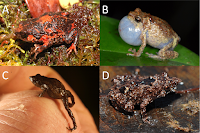 |
| (A) Choerophryne alpestris upper montane moss fields, Central Cordillera, terrestrial;(D) Choerophryne proboscidea hill forest forest, northern lowlands, scansorial. |
Abstract
Aims
Mountain ranges in the tropics are characterised by high levels of localised endemism, often-aberrant evolutionary trajectories, and some of the world’s most diverse regional biotas. Here we investigate the evolution of montane endemism, ecology and body size in a clade of direct-developing frogs (Choerophryne, Microhylidae) from New Guinea.
Methods
Phylogenetic relationships were estimated from a mitochondrial molecular dataset using Bayesian and maximum likelihood approaches. Ancestral state reconstruction was used to infer the evolution of elevational distribution, ecology (indexed by male calling height), and body size, and phylogenetically corrected regression was employed to examine the relationships between these three traits.
Results
We obtained strong support for a monophyletic lineage comprising the majority of taxa sampled. Within this clade we identified one subclade that appears to have diversified primarily in montane habitats of the Central Cordillera (>1,000 m a.s.l.), with subsequent dispersal to isolated North Papuan Mountains. A second subclade (characterised by moderately to very elongated snouts) appears to have diversified primarily in hill forests (<1,000 m a.s.l.), with inferred independent upwards colonisations of isolated montane habitats, especially in isolated North Papuan Mountains. We found no clear relationship between extremely small body size (adult SVL less than 15 mm) and elevation, but a stronger relationship with ecology—smaller species tend to be more terrestrial.
Conclusions
Orogeny and climatic oscillations have interacted to generate high montane biodiversity in New Guinea via both localised diversification within montane habitats (centric endemism) and periodic dispersal across lowland regions (eccentric endemism). The correlation between extreme miniaturisation and terrestrial habits reflects a general trend in frogs, suggesting that ecological or physiological constraints limit niche usage by miniaturised frogs, even in extremely wet environments such as tropical mountains.
Conclusions
Our new phylogeny and ecophenotypic data for the microhylid frog genus Choerophryne indicates that montane areas have been colonised via a complex suite of biogeographic processes, especially upslope colonisation and speciation in presumably novel highland habitats and dispersal between montane islands, and that the relative importance of these processes has differed across even closely related lineages. Choerophryne also shows a correlation between extremely small size and utilisation of terrestrial habitats, mirroring a global pattern that suggests that, in frogs, ecological or physiological constraints largely limit extremely miniaturised taxa to terrestrial microhabitats in tropical areas.
Paul M. Oliver, Amy Iannella, Stephen J. Richards and Michael S.Y. Lee. 2017. Mountain Colonisation, Miniaturisation and Ecological Evolution in A Radiation of Direct-developing New Guinea Frogs (Choerophryne, Microhylidae). PeerJ. 5:e3077. DOI: 10.7717/peerj.3077


